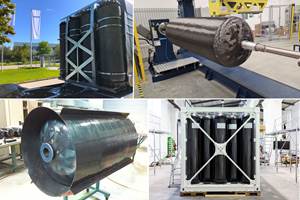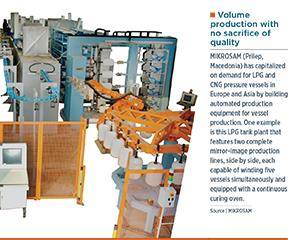Mikrosam delivers automated filament winding line to Magna
Integrated production cell for high-volume production of composite CNG tanks installed in Graz, Austria plant.
Composite manufacturing equipment supplier Mikrosam (Prilep, Macedonia) has delivered a fully automated filament winding line for CNG tanks to leading global automotive supplier Magna and installed the system in its Graz, Austria plant. This production cell was developed for manufacturing cost-effective, lightweight CNG tanks using composite materials, which could reduce vehicle weight by up to 50% and fuel expenses by up to 40%.
Mikrosam’s fully integrated composite manufacturing solution comprises:
- Multi-spindle filament winding machines with the company’s patented automated cut & restart of the fibers/tape during winding process;
- Automatic handling of liners and wound and cured tanks between numerous equipment units in the production process;
- Sophisticated curing oven that accommodates the requirements of different resin systems.
The winding machine is equipped with two winding carriages — one for winding the main composite structure and one for winding of the outer protective layer — enabling full continuous production of CNG tanks on the same machine in a single winding cycle. A total of 24 servomotor-controlled axes are integrated into the filament winding machine itself, which makes it one of the most advanced winding machines in the world.
This production line is also unique in its flexibility to change production from one tank size to another, with all programs — mechanical and electrical parts — automatically adjusted to the new CNG tank size. The ability to make these changes and adjust the capacity of each equipment station quickly increases productivity of the overall production line.
Control and monitoring of the work cell and overall manufacturing process is carried out from one place, the top level automation control system (TCON). It manages all modules in the integrated production line from one location while recording raw material consumption, complete production parameters, product tracking at every station and data for multiple quality check points.
In order to maintain high quality of the overall manufacturing process, Mikrosam develops control software and data acquisition systems that enable customer to see the line in operation, investigate it and discuss any issues before accepting final installation. After the production cell is installed in the customer facility, continued support via remote maintenance system is guaranteed. Software is updated for the lifetime of the automated production line.
Designed to fit the required high volume production capacities currently demanded, Mikrosam automated filament winding production cells optimize production rate by avoiding bottle necks; reduce material waste, increase energy efficiency and real-time control of quality at every point in the production cycle. Monitoring of the complete manufacturing process and integration of safety functions in all modes of operation are combined with flexibility in each equipment station. All of this is achieved in one package with full support, training and assistance from engineering experts.
Europe is the largest market for natural gas vehicles. With demand continuing to increase here and around the world, Mikrosam has used its 26 years of experience to develop the most advanced fully-automated, high-volume production line for filament-wound CNG, LPG and hydrogen tanks, as well as filament winding machines with up to 6-axes for complex parts; AFP/ATL machines; prepreg making and slitting equipment, and software products. Mikrosam has provided solutions to customers from more than 40 countries around the globe, including the European Union, Japan, China, Russia and India, enabling them to exceed their production objectives. For more information, visit Mikrosam at the CAMX 2016, Booth G 97.
Related Content
Materials & Processes: Fibers for composites
The structural properties of composite materials are derived primarily from the fiber reinforcement. Fiber types, their manufacture, their uses and the end-market applications in which they find most use are described.
Read MoreComposites end markets: Pressure vessels (2024)
The market for pressure vessels used to store zero-emission fuels is rapidly growing, with ongoing developments and commercialization of Type 3, 4 and 5 tanks.
Read MoreComposites end markets: Aerospace (2023)
With COVID in the past and passengers flying again, commercial aircraft production is ramping up. The aerocomposites supply chain is busy developing new M&P for an approaching next-generation aircraft program.
Read MoreForvia brand Faurecia exhibits XL CGH2 tank, cryogenic LH2 storage solution for heavy-duty trucks
Part of its full hydrogen solutions portfolio at IAA Transportation 2022, Faurecia also highlighted sustainable thermoplastic tanks and smart tanks for better safety via structural integrity monitoring.
Read MoreRead Next
Automated filament winding enables competitive composite cylinders
Carefully controlled, robust, volume processes offer fabricators of Class IV LPG/CNG tanks a means to meet increasing demand in Europe and Asia.
Read MoreComposites end markets: Energy (2024)
Composites are used widely in oil/gas, wind and other renewable energy applications. Despite market challenges, growth potential and innovation for composites continue.
Read MoreFrom the CW Archives: The tale of the thermoplastic cryotank
In 2006, guest columnist Bob Hartunian related the story of his efforts two decades prior, while at McDonnell Douglas, to develop a thermoplastic composite crytank for hydrogen storage. He learned a lot of lessons.
Read More

























